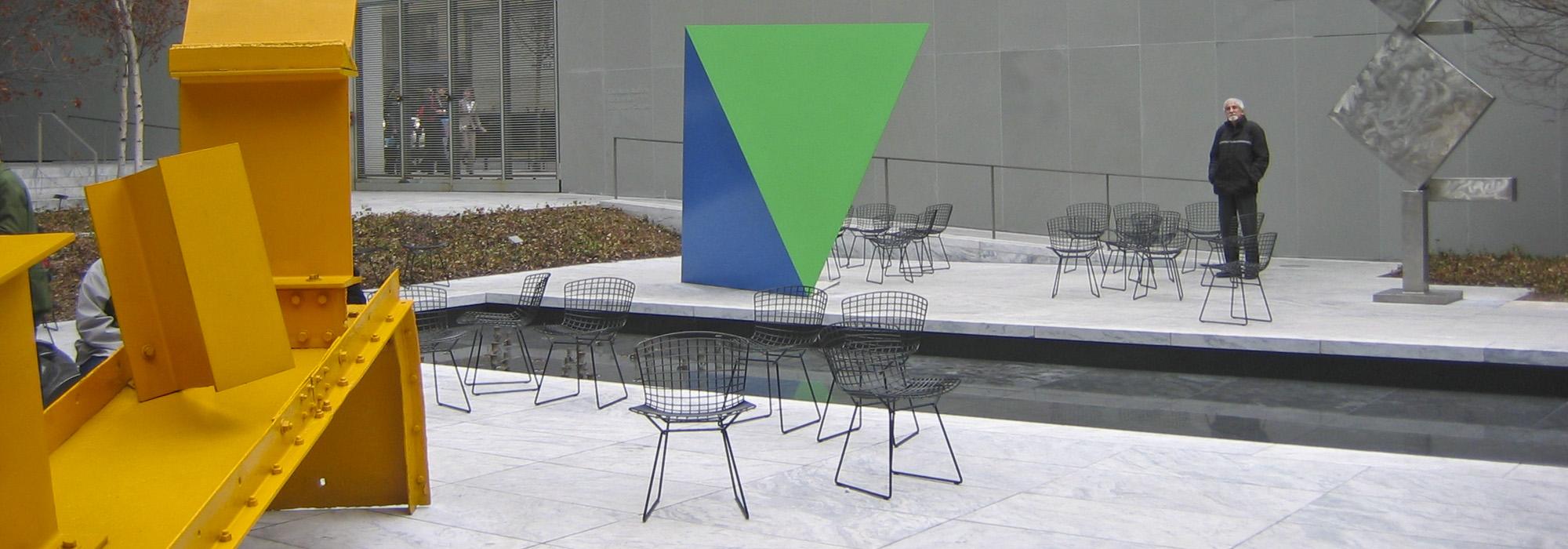Is the MoMA Sculpture Garden Doomed?
There’s plenty of new fuel for the perennial sport of Museum of Modern Art-bashing as the museum pursues a controversial expansion plan. Will MoMA raze the widely acclaimed former Folk Art Museum, designed by Tod Williams Billie Tsien Architects, to accommodate a Diller Scofidio + Renfro-designed expansion to its critically derided Taniguchi-designed home? Commentary is flying. Panels have been empaneled. The issue has attracted more players into a preservation debate than there are subpoenas in the Chris Christie-George Washington Bridge scandal. And, the atmosphere is heating up. Liz Diller survived one auto-da-fé already. The media is hyping this as personal because of the potential Grand Guignol involving two of architecture’s first couples.
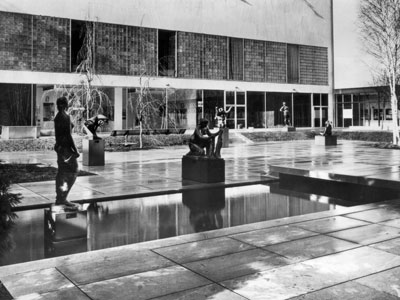
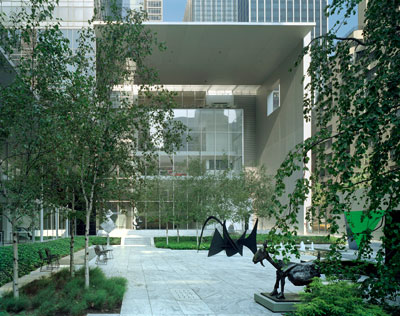
(upper) Historic image of MoMA Sculpture Garden; (lower) courtesy Donald
Richardson.Setting aside such dishy digressions, it’s encouraging to see this vigorous debate about an existential threat to recent work by celebrated practitioners – but where was the public discourse when Martha Schwartz’s award-winning design for Jacob Javits Plaza was replaced by Michael Van Valkenburgh’s work? Schwartz’s design at 15 was barely older than the Folk Art Museum. Is it different for building architecture than landscape architecture?
Maybe the Javits situation needed a “get out of jail free” card, which is what MoMA officials hope they have in offering some form of increased public access to their famed Abby Aldrich Rockefeller Sculpture Garden. Well, not so fast. Robin Pogrebin’s recent New York Times article, “MoMA’s Proposal for Sculpture Garden Pleases and Riles”, quoted six landscape architects including James Corner, Ken Smith, Laurie Olin and Michael Van Valkenburgh – which may be a record for the number of landscapes architects quoted in a Times article under 1,200 words in length – and opinions differ. Smith says: “It’s a good idea.” Olin, however, is skeptical: “They’re using [a promise of increased access] to pacify people about something else that has people upset, and in the course of it, they’re watering down what was special.”
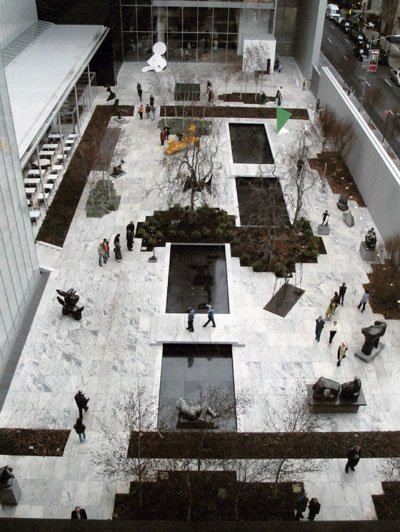
Image by George Hauner, courtesy Donald RichardsonIf MoMA throws open its garden, what could happen? How do stewards of cultural landscapes, whether an individual site (like the garden), a larger site (like New York’s High Line), or a much, much large site (like the City of Savannah), manage the visitor experience, which ranges from restorative contemplation to active stimulation? And, how do you balance the needs of residents vs. tourists? Savannah,whose residential population is under 150,000, had more than 12 million tourists in 2011 (up from 6.85 million in 2006). The High Line’s 2013 visitation was 4.8 million people, 50% of them residents, vs. 3.7 million in 2011, which was double the 2010 number. Balancing the needs of tourists and residents is difficult work. “Our challenge is to figure out how to sustain the park as a special place for New Yorkers, and we are actively working toward this goal," writes Kate Lindquist, a Friends of the High Line staffer. "We are exploring ways to make it easier for New Yorkers to know when visitation is at its peak, such as live Web cams, Twitter updates, and more.” Maybe it’s time for some form of congestion pricing or HOV (High Occupancy Visitor) lanes.
With increased access, a site risks being loved to death. Philip Johnson, designer of MoMA’s sculpture garden, addressed its carrying capacity in the 1994 book Philip Johnson: The Architect in His Own Words. Johnson fieled the direct question: “Is [the garden] at its best when there are very few people in the garden or when there are a lot?” Johnson replied: “It's better to have a few, of course, because then you get the feeling of the space. But it can take solid crowds.” That takes us back to how we measure success in terms of the visitor experience. Johnson himself said: "You need a place to relax after looking at the artwork. You're so relieved that there is no painting to focus on.”
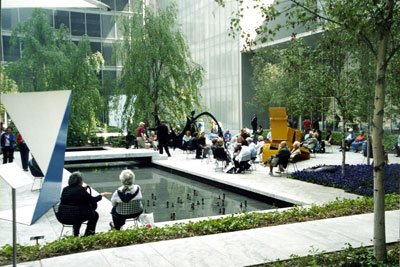
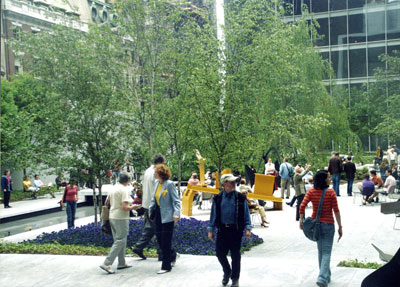
Photos courtesy Donald Richardson.The Central Park Conservancy has successfully implemented a sort of crop rotation for people by luring visitors north with the addition of the Charles A. Dana Discovery Center on the Harlem Meer (opened in 1993) and shifting locales for where dogs run off leash (among other means) to meet the needs of visitors while maintaining the site’s integrity. By contrast, the lawn of the National Mall in Washington, DC frequently looks bedraggled, which is why the annual National Book Festival is being moved to DC’s convention center. Johnson’s Glass House in New Canaan, CT, has limited visitation, as does Hillwood Estate, Museum and Garden in Washington, DC, but both are in residential neighborhoods, which imposed the limits. (Glass House’s stewards did apply to increase the number of visitors, but withdrew the application following backlash from neighbors.)
The debate about MoMA’s garden raises bigger issues that design professionals, stewards and advocates must balance, particularly with the renaissance and growth of the urban core. Can success be measured by valuing the quality of an experience that honors a site’s design intent rather than the greatest number of visitors? Is less more? In his 1988 treatise City: Rediscovering the Center, the great social and cultural theorist William H. “Holly” White posed this question: "What if we were to succeed too well? Conceivably, so many more people might be attracted as to crowd out the values they came to enjoy." MoMA must be careful what it wishes for.
Since a version of this opinion piece originally appeared in ARCHITECT (February 12, 2014), there has been considerable discussion about access to site's such as MoMA's Sculpture Garden. Lloyd Alter at TreeHugger has penned an article titled Should all parks be public? that includes an online poll.



